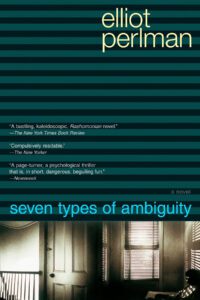
Author: Elliot Perlman
Publication Year: 2003
Length: 640 pages
Ambiguity is one of those words that I only understand in context. As a stand-alone word, it’s slippery and ever-morphing. I’d be hard-pressed to come up with a solid definition off the top of my head, yet I know it when I see it.
This novel, not unlike the word itself, seems to insinuate itself in the cracks of my brain, not really leaving an impression so much as trails of substance in the corners of my vision. Every time I thought I had a handle on what Elliot Perlman was trying to pull off, someone threw that softball at the little metal target and I was dunked into a tank of cold murky water. Not being all that practiced in my metaphors, I’m sure this one is deficient in more ways than you can count, but it’s the best way I can describe the way I felt for large chunks of the narrative.
The story itself is a simple one. A lonely, desperate and delusional man, Simon, steals the child of an ex-girlfriend, takes him home to his apartment and gives him chocolate milk. Really, that’s the story. The larger idea of why he did it, and who feels the repercussions, is the text that fills up the 600 some odd pages.
Wrapped up in this little plot is the hooker friend of Simon the child-stealer. That hooker friend also happens to have the husband of the ex-girlfriend (and father of the stolen child) as a long-time regular client. These four are really the core characters, along with Simon’s shrink, Alex, who eventually becomes his advocate when Simon is arrested for the kidnapping of the child. There is also a co-worker of the husband, and the eventual adult child of the shrink. I think that makes seven.
Being a total sucker for interesting narrative structures, I do like the way the book is set up, telling an overlapping story from seven different perspectives. As each of the seven characters continues the semi-linear story, we uncover nuances the last character held back, omitted or outright lied about. I do think that the author could have pushed this a bit more, as it really would have given us some insight into human nature and their propensity to explain away things that their brains can’t deal with. Ultimately, though, can we really trust any of the narrators? Funny enough, the author doesn’t really give us that sense of ambiguity that we crave, akin to the story told by Verbal Kint in The Usual Suspects. So rather then creating ambiguity, the author played it more straight and used the technique to reveal truths and uncover lies rather than cause doubt in the mind of the reader.
I know it sounds weird, but sometimes a little bit of doubt is okay. What the hell happened at the end of Rocky III after Clubber ding-dinged? It’s that speculation and lack of clarity that sometimes drives the most compelling storylines. Too often Perlman got bogged down in his own convoluted psychobabble, mired in high-minded pabulum that seemed more appropriate for a textbook or lecture than a book. This is where a good editor should have stepped in and trimmed the fat a little. There were literally times where I could think of nothing but the old Pitfall game and those damn quicksand traps. I would be sitting there slogging through some impenetrable page and the little 8-bit jungle dude would scramble across the page and get stuck right there on page 423 in the paragraph about brain synapses or whatever.
If I were to ever write a book the first thing I’d do is find a really good editor. The second thing I’d do is steal this narrative structure and put it to better use. There are bits of this book that really shine, but in the end, despite the story’s simplicity, it couldn’t overcome its dense and serious subject matter. Oh, and the lead character, Simon, is (most likely unintentionally) a borderline psychotic whiny shithead who I found practically impossible to like.


